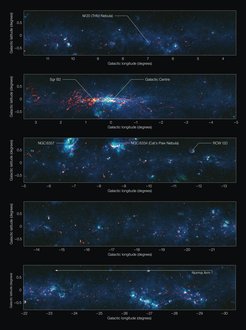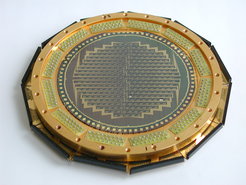Mapping the Cold Universe
APEX Telescope provides astronomer's a new guide to the Galaxy

This new guide for astronomers, known as the APEX Telescope Large Area Survey of the Galaxy (ATLASGAL) shows the Milky Way's emission at submillimeter-wavelengths (between those of infrared light and radio waves). Images of the cosmos at these wavelengths are vital for studying the birthplaces of new stars and the structure of the crowded galactic core.
"ATLASGAL gives us a new look at the Milky Way. Not only will it help us investigate how massive stars form, but it will also give us an overview of the larger-scale structure of our Galaxy", says Frederic Schuller from MPIfR, leader of the ATLASGAL team.
The area of the new submillimeter map is approximately 95 square degrees, covering a very long and narrow strip along the Galactic plane two degrees wide (four times the width of the full Moon) and over 40 degrees long. The 16 000 pixel-long map was made with the LABOCA submillimeter-wave camera on the ESO-operated APEX telescope. APEX is located at an altitude of 5100 m on the arid plateau of Chajnantor in the Chilean Andes - a site that allows optimal viewing in the submillimeter range.
The interstellar medium - the material between the stars - is composed of gas and grains of cosmic dust, rather like fine sand or soot. However, the gas is mostly hydrogen and relatively difficult to detect, so astronomers often search for these dense regions by looking for the faint heat glow of the cosmic dust grains.
Submillimeter light allows astronomers to see these dust clouds shining, even though they obscure our view of the Universe at visible light wavelengths. Accordingly, the ATLASGAL map includes the denser central regions of our Galaxy, in the direction of the constellation of Sagittarius, that are otherwise hidden behind a dark shroud of dust clouds.
The newly released map reveals thousands of dense dust clumps, many never seen before, which mark the future birthplaces of massive stars. The clumps are typically a couple of light-years in size, and have masses of between ten and a few thousand times the mass of our Sun, enough to give birth to stars or even clusters of stars. In addition, ATLASGAL shows diffuse emission connecting these clumps and has captured images of beautiful filamentary structures and bubbles in the interstellar medium, blown by supernovae and the winds of bright stars.
Fig. 1 shows in comparison the star forming clouds and complexes as observed in ATLASGAL, together with hotter dust of more evolved young stars still embedded in their dust cocoons, as observed in the Midcourse Space experiment (MSX) at infrared wavelengths.
Some striking highlights of the map include the centre of the Milky Way, the nearby massive and dense cloud of molecular gas called Sagittarius B2, and giant star forming complexes like NGC 6357 and NGC 6334, the Cat's Paw Nebula.
"Every single compact source in the ATLASGAL survey shows us a place at which new stars are presently being formed", says Prof. Karl Menten, APEX principal investigator, director at MPIfR and team member of the ATLASGAL project. "We just have to point APEX or Herschel and, in future, ALMA towards these positions to observe the molecules associated with the dust to get a full picture of star formation throughout our Milky Way."


ATLASGAL is a collaboration between the Max-Planck-Institut für Radioastronomie, the Max-Planck-Institut für Astronomie, astronomers from the ESO community, and Universidad de Chile. The observations are presented in a paper by Frederic Schuller et al., to appear in Astronomy & Astrophysics.
LABOCA (Large APEX Bolometer Camera), one of APEX's major instruments, is the world's largest bolometer camera (a "thermometer camera", or thermal camera that measures and maps the tiny changes in temperature that occur when sub-millimeter wavelength light falls on its absorbing surface). LABOCA's large field of view and high sensitivity make it an invaluable tool for imaging the "cold Universe". LABOCA was built by the Max-Planck-Institut für Radioastronomie.
APEX, the Atacama Pathfinder Experiment is a 12-meter telescope, located at 5100 m altitude on the arid plateau of Chajnantor in the Chilean Andes. APEX operates at millimeter and submillimeter wavelengths. This wavelength range is a relatively unexplored frontier in astronomy, requiring advanced detectors and an extremely high and dry observatory site, such as Chajnantor. APEX, the largest submillimeter-wave telescope operating in the southern hemisphere, is a collaboration between the Max-Planck-Institut für Radioastronomie, the Onsala Space Observatory and ESO. Operation of APEX at Chajnantor is entrusted to ESO.


